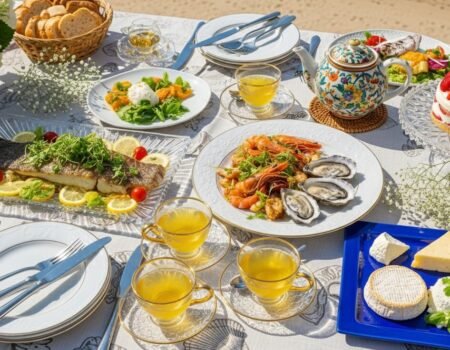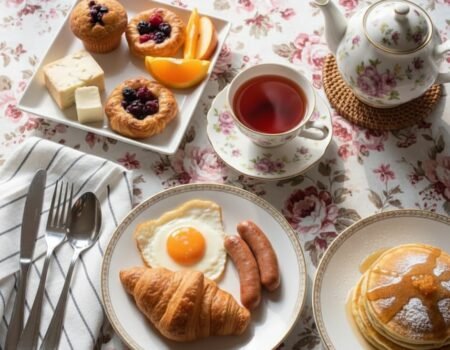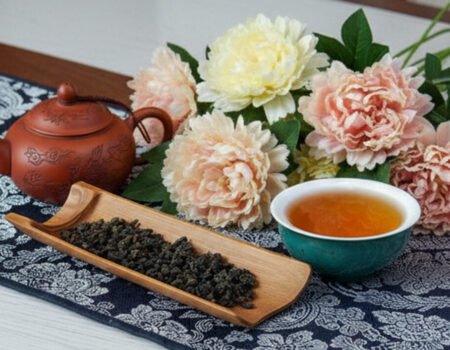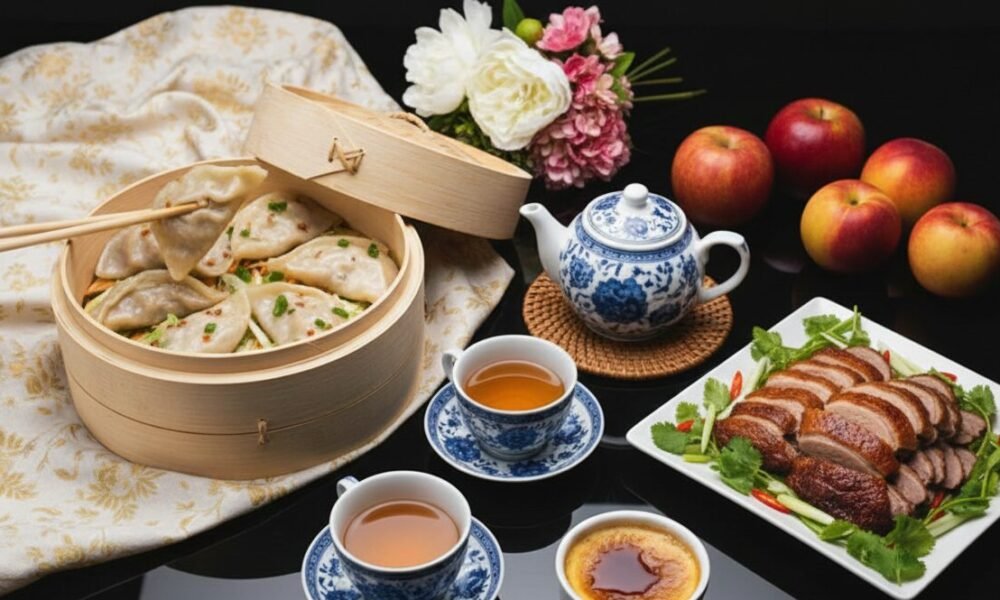
What Pairs Well with Oolong Tea: From Seafood to Sweets
Index
Oolong tea sits in this interesting space between green and black teas, and honestly, that’s what makes it so fun to pair with food.
This guide will walk you through tried-and-true pairings that work beautifully. You’ll find clear examples, simple tips, and a few surprises along the way.
Key Takeaways
- Oolong tea’s flavor profile, shaped by oxidation levels ranging from lightly to heavily oxidized, determines ideal pairings with seafood, pastries, meats, and cheeses.
- Light oolongs like High Mountain or Alishan enhance sweet breakfasts and fruit desserts, while dark roasted types such as Da Hong Pao complement rich meats and aged cheeses.
- Medium oolong teas balance both savory foods and desserts due to their layered flavors that align well with quiches, croissants, pasta dishes, or spiced cakes.
- Classic Chinese dishes including dim sum and Peking duck pair best with oolong’s floral-to-roasted spectrum; multiple brews sustain enjoyment during long meals.
- For dessert pairings, dark roasted oolongs elevate caramel treats while both light and medium varieties emphasize nut-based or stone-fruit pastries.
What Are the Flavor Characteristics of Oolong Tea?
Oolong tea offers a complex flavor profile that ranges from floral and sweet to rich and toasty. This makes it perfect for creative tea pairing.
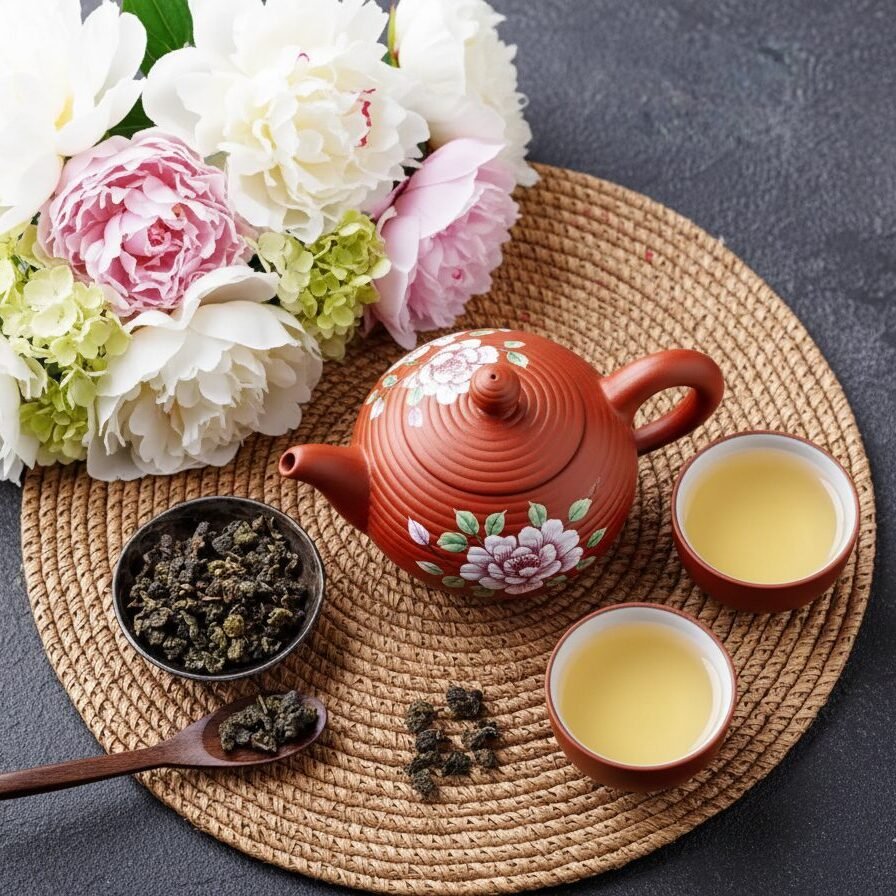
Each type of oolong provides unique aromas and flavors that excite your taste buds. The versatility comes from how tea makers process the leaves.
Oxidation Levels and Flavor Spectrum
Oxidation levels in oolong tea shape its entire flavor profile, aroma, and color. Tea makers carefully control oxidation from less than 50 percent for light oolongs to more than 50 percent for dark or roasted types.
This spectrum of oxidation transforms the tea leaves from green to rich amber or deep brown shades. Lightly oxidized teas taste floral and bright, with fresh notes similar to green tea or mountain air.
Highly oxidized varieties develop intense flavors that resemble black tea. They offer hints of honey, dried fruit, spice, and even a toasted edge.
The degree of oxidation is a defining factor in both taste and pairing compatibility.
Popular examples include Tieguanyin as a lightly oxidized oolong and Wuyi Rock Tea as a darker style with bold roast character. Major brands like Harney & Sons and The Republic of Tea offer premium oolong varieties for home enthusiasts.

The process includes withering the leaf, partial oxidation for complexity, then skillful curling that preserves unique flavors. These steps help create layers ranging from sweet citrus and apricot tones to smoky coffee bean aromas.
Because of this wide range in intensity, oolong offers great flexibility for pairing with foods like seafood or chocolate desserts based on its type.
Floral and Fruity Notes

High Mountain Oolong from central Taiwan excites many tea enthusiasts with its light, crisp flavor layered with floral notes. This type of oolong contains scents reminiscent of spring flowers and fresh-cut grass.
Iron Goddess of Mercy, a traditional favorite in Fujian, China, undergoes slow roasting for up to 60 hours. This careful process brings out delicate orchid aromas along with an inviting sweetness that suits both new drinkers and experienced palates.
Pear Mountain Oolong from Taiwan stands out for its pear-like aroma and mellow honey undertones. Alishan Oolong often enchants tasters with a gentle orchid scent mixed into sweet creaminess.
Light oxidation helps preserve these flowery flavors. According to tea expert Gi Na, who received the Sommelier Award in the 2025 MICHELIN Guide Beijing, “The sweet and smooth profile of Oolong tea can counteract the spiciness of certain dishes.”
Fruity oolongs match well with snacks like apples, cherries, plums, peaches, mangoes, apricots, or pineapple. These characteristics make this type of tea ideal for serving alongside sweet pastries or bright stone-fruit desserts.
Roasted and Toasty Profiles
Moving from the soft floral notes, some oolong teas take on roasted and toasty profiles through special processing. Wuyi Oolong, such as Da Hong Pao, stands out for its deep oxidation and long roasting time of up to 60 hours.
These teas develop strong smoky flavors with hints of caramel, butter, and toasted nuts that linger on the palate. Red Rock Tea House specializes in authentic Wuyi Rock Oolong cultivated from exclusive tea fields in Wuyi Mountain.
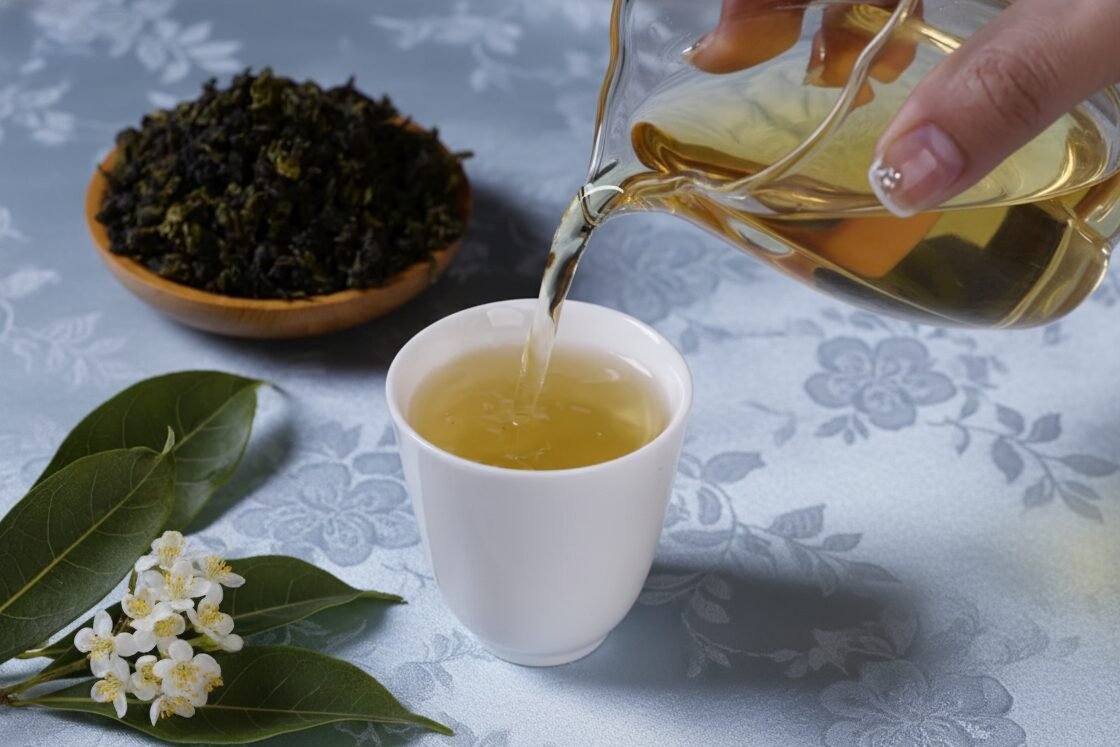
The mineral-rich body in dark roasted oolongs makes them ideal for pairing with savory foods like smoked meats or barbecue. Their bold taste can cut through rich or fatty dishes while enhancing umami flavors found in aged cheese or grilled preparations.
According to a 2012 study published in Current Biology by Suntory Global Innovation Center, oolong tea has the ability to emulsify fats, which helps remove oils from the mouth and reduces the sensation of greasiness.
Complex layers emerge during roasting. This offers a nuanced alternative to darker teas such as Pu-erh when seeking unique food pairings within Chinese cuisine or Western meals.
How Does Oxidation Level Affect Oolong Food Pairing?
The oxidation level shapes the flavor of oolong tea and guides which foods pair well with each type. You can unlock new taste experiences by exploring how light, medium, or dark oolong varieties enhance your meal choices.
Light Oolong Pairings
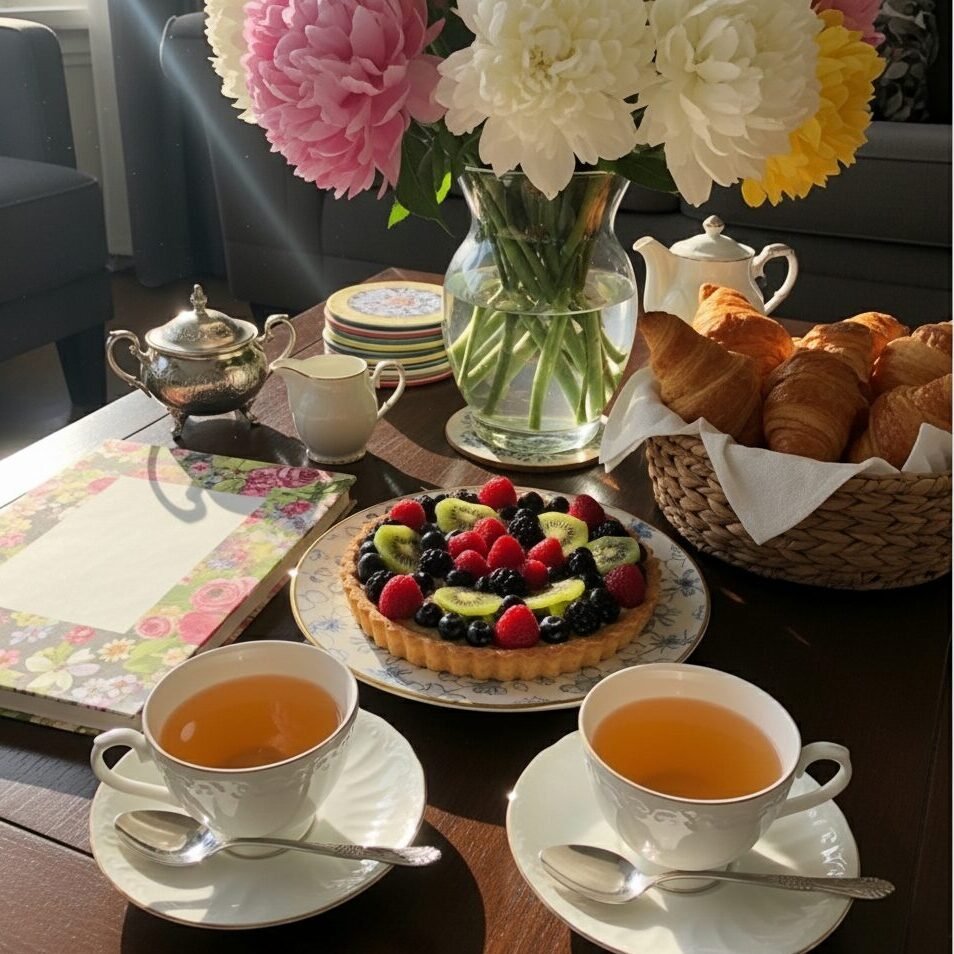
Light oolong teas have subtle aromas and a delicate flavor profile. They feature floral, fruity, and creamy notes that highlight many foods without overpowering them.
- High Mountain Oolong and Alishan Oolong enhance sweet breakfast foods like pancakes or waffles; their gentle taste blends well with maple syrup and buttery textures.
- Fruity or floral light oolongs intensify the experience of fruit desserts, including berry cobblers, peach pie, or poached pears, by amplifying both aroma and sweetness.
- A cup of light oolong tea pairs beautifully with fresh fruit such as cherries, citrus slices like lemon or grapefruit, strawberries, blueberries, mangoes, peaches, apricots, pineapple chunks, apples, or plums.
- These teas match delicately flavored pastries like scones or macarons; the pairing highlights subtle flavors in both tea and pastry without masking mild notes.
- Light oolongs complement soft cheeses or non-spicy meats on charcuterie boards; their smooth mouthfeel provides balance to salty flavor and creamy texture.
- Fragrant light oolongs work well with desserts containing meringue or custard, including pavlova, by echoing sweet vanilla notes in each bite.
Leading tea sommelier at Cookies Cream (Michelin-starred restaurant) notes that tea introduces a new language with herbal, smoky, and floral notes. For afternoon snacks, light oolong matches mild teacakes or airy pastries filled with whipped cream or lemon curd for a gentle lift in both taste and quality.
Medium Oolong Pairings
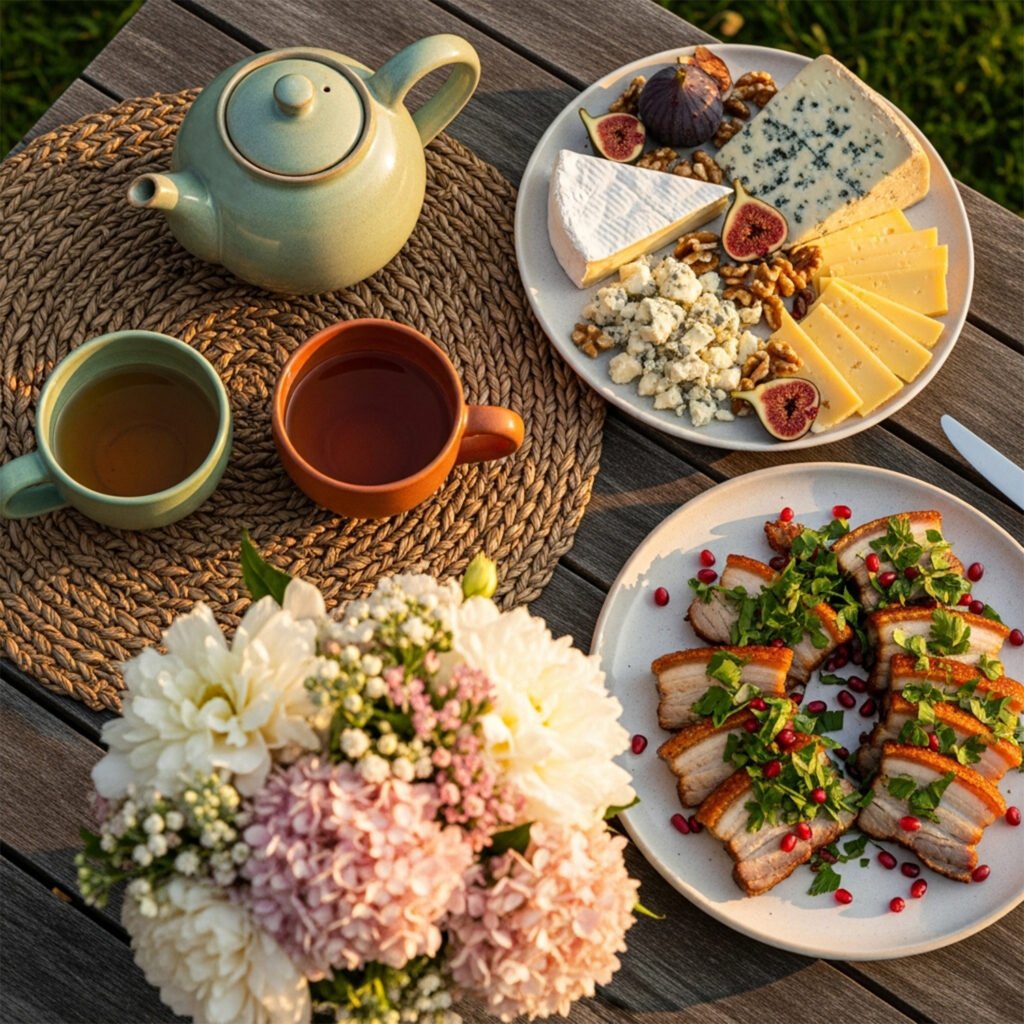
Medium oolong tea has a balanced flavor and aroma, which makes it ideal for many food pairings. Its layers of flavor work well with both savory foods and desserts.
- Dong Ding Oolong, a hand-rolled Taiwanese tea from Nantou County, complements roasted nuts or honey-glazed nuts because of its rich, roasted aroma.
- Medium oolongs balance the flavors in quiche and croissants at brunch; the delicate pastry texture stands up to the tea’s toasty notes.
- Pair medium oolong tea with spiced desserts like cinnamon pastries or carrot cake; the aromatic spices match beautifully with the fragrant oxidation profile.
- Enjoy medium oolong alongside nut-based pastries or fall fruit tarts for breakfast; these choices enhance both the richness and sweetness of the brew.
- Medium oolongs work well with cheese boards containing aged cheese and charcuterie, especially when paired with honey or candied fruit.
- Oily cold cuts such as salami taste less heavy when enjoyed with mountain oolong tea due to its ability to cut through fats.
Sandwiches, including burgers topped with citrus slices or mint leaves, pair perfectly because the bright freshness underscores the tea’s complex finish. Creamy pasta dishes become lighter on the palate during your dinner when paired with medium-oxidized oolong thanks to its cleansing aftertaste.
Dark Roasted Oolong Pairings
Dark roasted oolong tea has a rich flavor and strong aroma. Its smoky, toasty taste makes it perfect for pairing with bold dishes and sweets.

- Wuyi Oolong (Da Hong Pao) pairs especially well with smoked meats like duck or BBQ due to its mineral-rich, highly oxidized profile.
- This tea matches aged, pungent cheeses such as Gouda, Cantal, or Cheddar on a charcuterie board for a satisfying tasting experience.
- Dark roasted oolongs enhance the flavor of spicy meats, acting as an alternative to heavy liquors at hearty meals.
- Grilled or roasted poultry brings out the buttery and smoky notes found in dark oolongs, amplifying both taste and aroma.
- These teas work well with chocolate desserts that include caramel or toasted nuts; their robust structure stands up to sweet richness.
- Foods containing bold umami flavors like soy-glazed beef or mushroom stir-fry highlight the depth of dark oolong’s roasted character.
Curries, spicy rubs, or barbecue offer enough intensity to balance the complexity of dark oolong without overpowering its delicate mineral undertones. According to Twinings, a leading UK tea brand established in 1706, oolongs tend to vary but are generally quite smoky and complex, pairing perfectly with herby dishes and smoked meats.
This variety offers many health benefits while keeping caffeine content balanced. It fits diverse menus and bridges different flavors in ways that elevate your dining experience.
What Foods Pair Best with Light Oolong Tea?
Light oolong tea pairings offer a refreshing balance of delicate flavors and aromas. You’ll discover which dishes best highlight its subtle beauty as you explore these combinations.
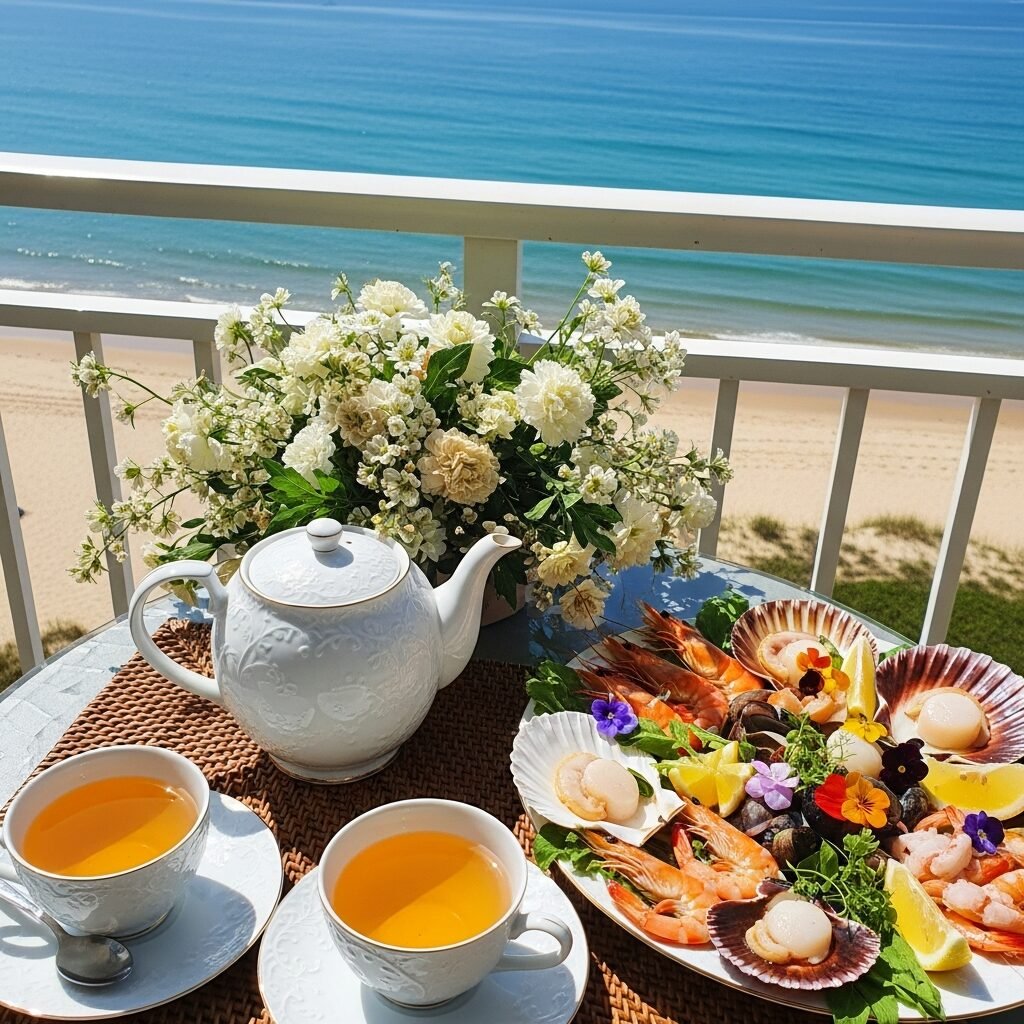
Light Oolong with Seafood
High Mountain Oolong, such as Gaoshan, works well with seafood due to its mild and floral notes. The tea’s crispness matches the delicate texture of poached or lightly grilled fish.
Pear Mountain Oolong highlights the natural sweetness in shellfish like scallops or shrimp. Its subtle floral undertones don’t overpower gentle flavors.
Pairing lightly oxidized oolongs with steamed white fish lets each bite stay fresh. These teas balance the briny character of oysters and enhance sushi or seafood salads for a more refreshing combination, especially in warm weather.
Serving light oolong as an iced tea brings out even more brightness while keeping flavors clean and balanced. At Lu Shang Lu, a two-MICHELIN-star restaurant in Beijing, tea sommelier Gi Na pairs fragrant oolongs with delicate seafood dishes to create harmonious flavor experiences.
Light Oolong with Delicate Pastries
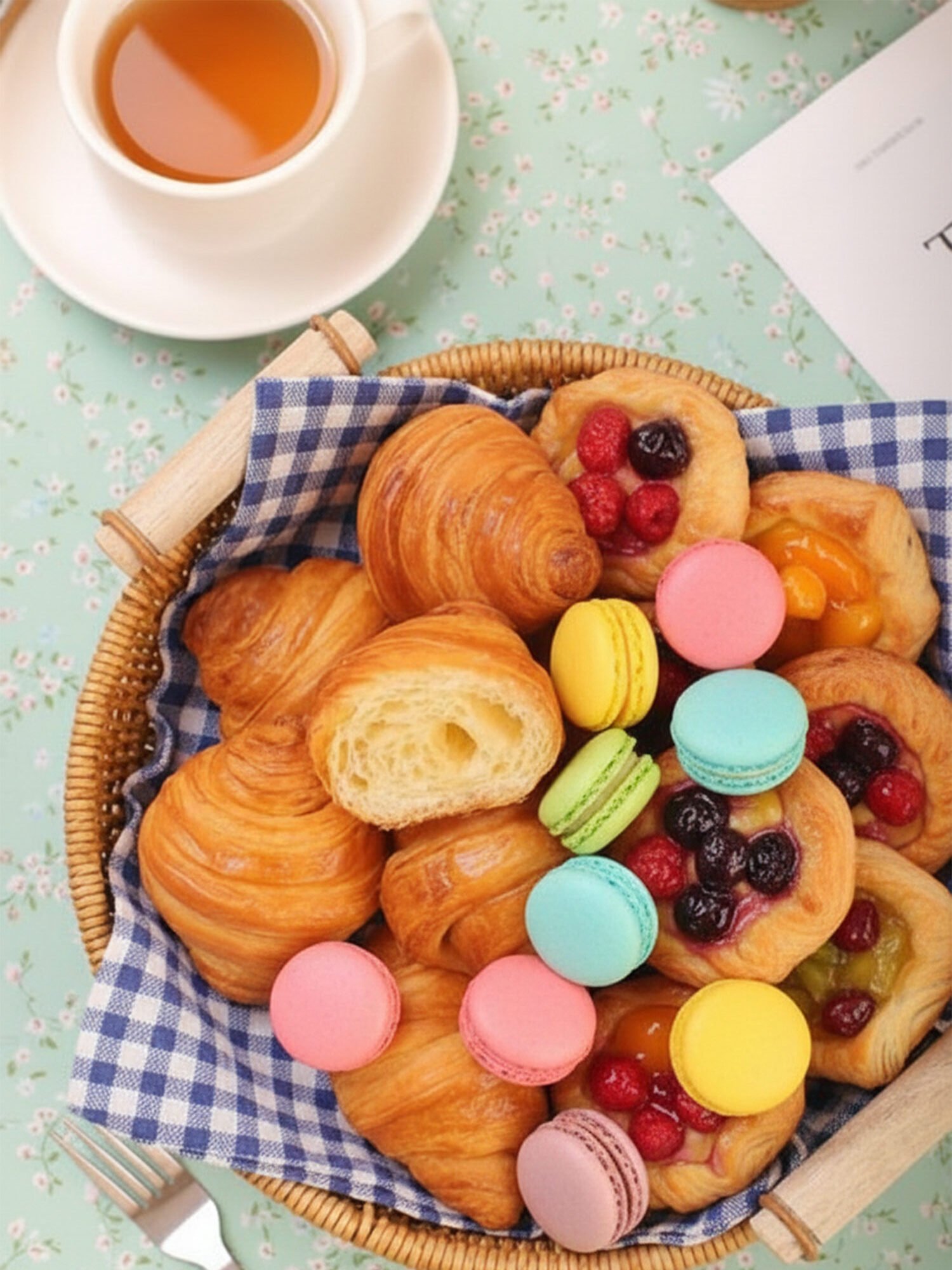
While light oolongs refresh the palate after seafood, they also shine next to delicate pastries. Alishan and Dong Ding tea offer floral or creamy notes that blend beautifully with croissants, teacakes, and pastel-colored macarons.
Butter-rich scones and flaky biscuits benefit from the gentle flavoring of these teas. White chocolate-infused tarts find a sweet spot alongside lightly oxidized oolong varieties.
You can pair your favorite cup with meringue, custard desserts, or even pavlova for afternoon tea settings. The moderate sugar in vanilla or fruit-filled pastries doesn’t overpower the subtle taste profiles of light oolong.
Almond or honey-glazed treats enhance the natural sweetness of the brew without masking its aroma. Pastry chefs sometimes drizzle fruit syrups over pastry selections to create harmony between tea and dessert flavors during pairing sessions.
Flavor preference plays a key role. Some people enjoy adding mint leaves beside their sweets for extra freshness in every sip.
Light Oolong with Fresh Fruits
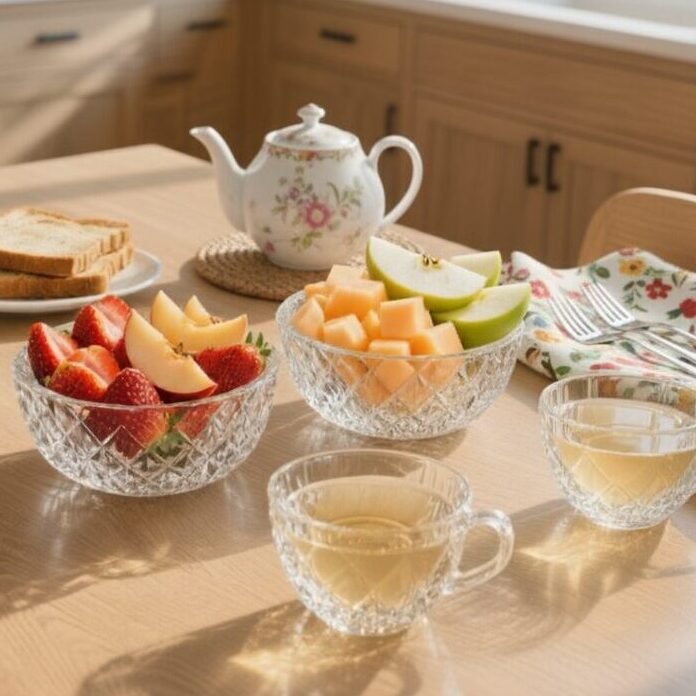
Light oolong pairs well with cherries, strawberries, blueberries, apples, plums, peaches, pears, mangoes, apricots, and pineapple. The tea’s floral sweetness enhances the tartness of citrus fruits and makes a perfect pairing for fruit platters featuring mint or other herbs.
Many cultures enjoy light oolong iced with slices of fresh fruit as a refreshing snack during warm months. Fresh stone fruits like plums or poached pears can highlight the natural flavor and texture of both the tea and the fruit.
Light oolongs also balance well with fruit-based desserts such as breakfast pavlova or mixed berry tarts. These delicate pairings suit brunch tables and offer a bright start to any meal focusing on lighter flavors.
What Foods Pair Best with Dark Oolong Tea?
Dark oolong’s rich taste stands up to bold, complex foods and brings out unexpected flavors in both sweet and savory dishes. You’ll want to explore pairings that highlight the toasty, floral notes unique to this tea variety for a truly satisfying tasting experience.
Dark Oolong with Rich Meats
Da Hong Pao oolong, a prized Chinese tea from the Wuyi region, pairs well with smoked meats and BBQ. Its toasted and mineral-rich notes match perfectly with fatty or charred meats like duck or pork belly.
This type of oolong offers a smoky profile that stands up to bold flavors. You can enjoy it with spice-rubbed ribs or slow-braised lamb.
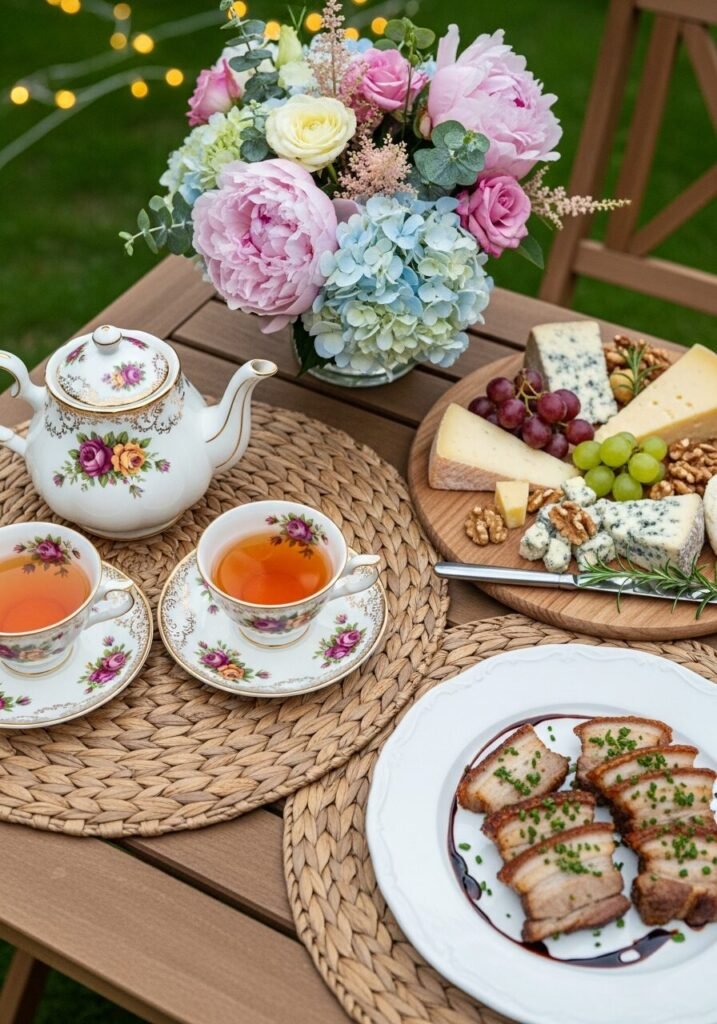
The strong taste of dark roasted oolongs balances rich dishes without overpowering them. This makes it ideal for meat-based charcuterie boards or aged sausages.
Wuyi oolong also complements spicy foods by adding depth rather than heat. Meat lovers notice how these teas enhance gamey flavors in venison while still cleansing the palate after each bite.
According to research from Suntory, pairing oolong with greasy foods creates what they call “the perfect marriage,” as the tea’s ability to emulsify fats increases enjoyment of higher fat content dishes.
Dark Oolong with Aged Cheese
After pairing dark oolong with rich meats, the tea’s complexity extends to aged cheese boards. Dark roasted oolongs like Wuyi tea shine next to aged cheeses such as Gouda, Cantal, and sharp Cheddar.
The smoky, buttery notes in these teas match the nutty flavors found in semi-hard and hard cheeses. Their mineral content balances cheese pungency while amplifying umami depth.
Serving hot dark oolong highlights each taste note without letting spicy condiments overwhelm the palate. You can enjoy these varieties with double- or triple-cream cheese for added richness.
Enhance your pairing by adding honey, savory dips, or dried fruits on your charcuterie board. This brings out a range of flavors from both the tea and the cheese selection.
Dark Oolong with Chocolate Desserts
Moving from strong aged cheese, dark roasted oolongs also stand out with chocolate desserts. Teas such as Da Hong Pao offer lingering butter and caramel notes that bring out the richness in chocolate.
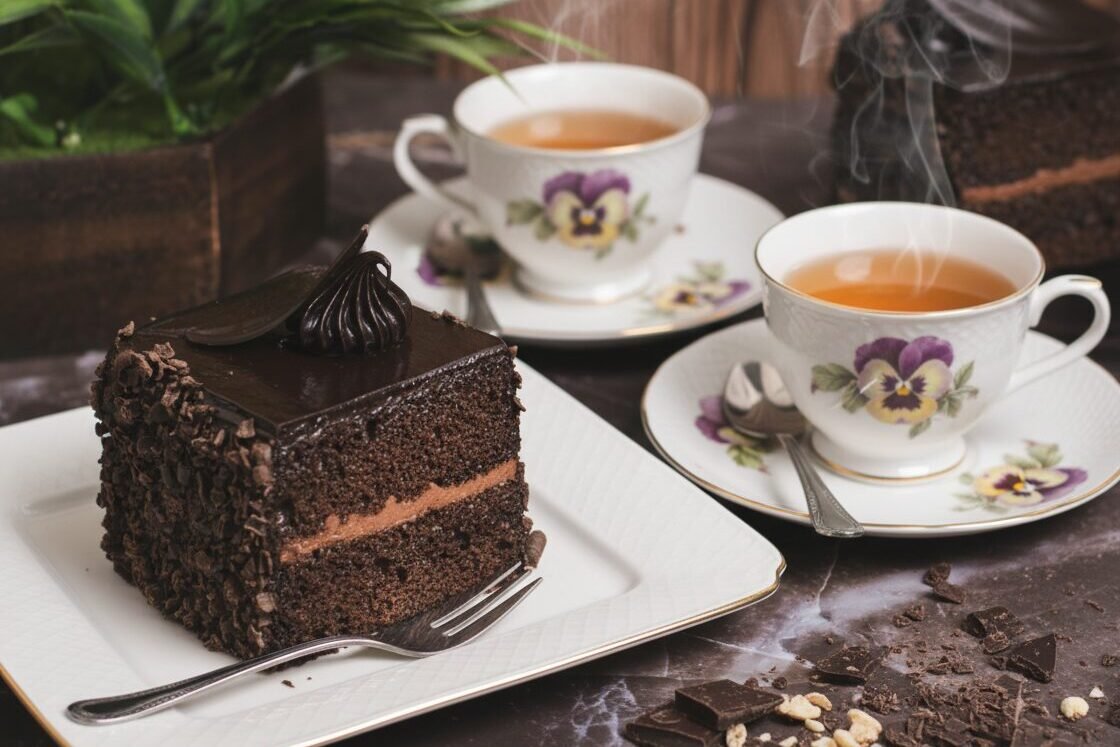
A cup of heavily oxidized oolong highlights the smoky depth found in dark or spiced chocolates. According to tea and chocolate pairing experts, dark oolongs pair exceptionally well with chocolate containing 70% cocoa or higher.
You can pair these teas with dense chocolate cakes, brownies, or even chocolate-covered pecans for an elevated touch. Chocolate panna cotta and mousse taste richer next to a sip of Wuyi rock tea because their flavors match well.
Spiced or candied fruit inside a dessert works beautifully. The dark oolong’s toasted profile complements bold candy flavors, similar to how coffee roasting adds layers.
This combination tastes indulgent but stays balanced so both the tea and dessert can shine together at any gathering or after-dinner treat.
How Does Oolong Pair with Chinese Cuisine?
Oolong tea’s unique oxidation levels make it a favorite pairing for classic Chinese dishes. Its balance of floral notes and roasted aromas adds depth to many traditional meals.
Oolong with Dim Sum
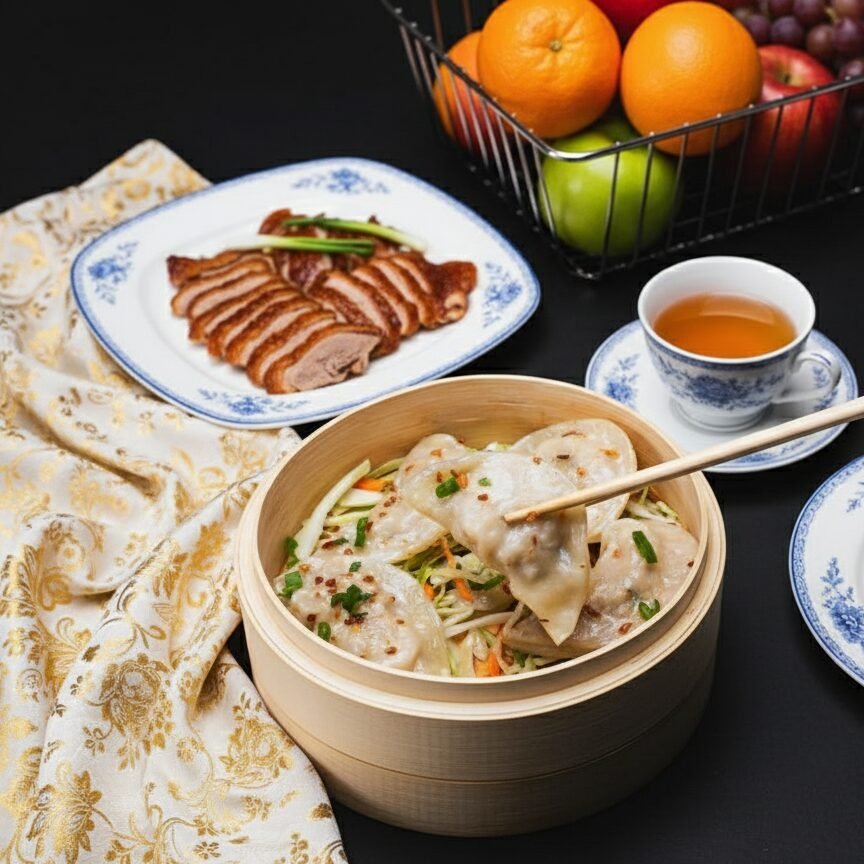
Tea houses in China often serve oolong tea with dim sum. Lightly oxidized varieties, such as Tie Guan Yin, complement delicate shrimp dumplings and steamed bao.
The floral and roasted notes of these tea varieties balance both subtle seafood flavors and savory fillings. You’ll notice how the slight astringency helps cut through fried textures like spring rolls or pork buns.
A pot of oolong supports the leisurely pace common to a dim sum meal. Multiple infusions allow you to enjoy each round of food without overpowering your taste buds.
According to traditional Cantonese dim sum culture, the phrase “yum cha” literally means “drink tea,” reflecting how integral tea is to the entire experience. Oolong’s complexity matches the wide range found on most dim sum carts, making it a popular choice for those who value both taste and tradition.
Oolong with Peking Duck
Dark roasted oolongs like Da Hong Pao pair exceptionally well with Peking duck. The smoky and toasty notes in these teas enhance the crisp skin and bring out the umami flavor of the duck meat.
Oolong’s mineral-rich character, especially from Wuyi varieties, matches perfectly with savory dishes rooted in Chinese banquet culture. The tea’s complex profile and caramel undertones echo the sweet, roasted elements found in both coffee and chocolate desserts but specialize in balancing rich meats such as duck.
Sipping dark oolong during a meal helps cut through fatty richness. It stands up to bold flavors like hoisin sauce that often accompany Peking duck.
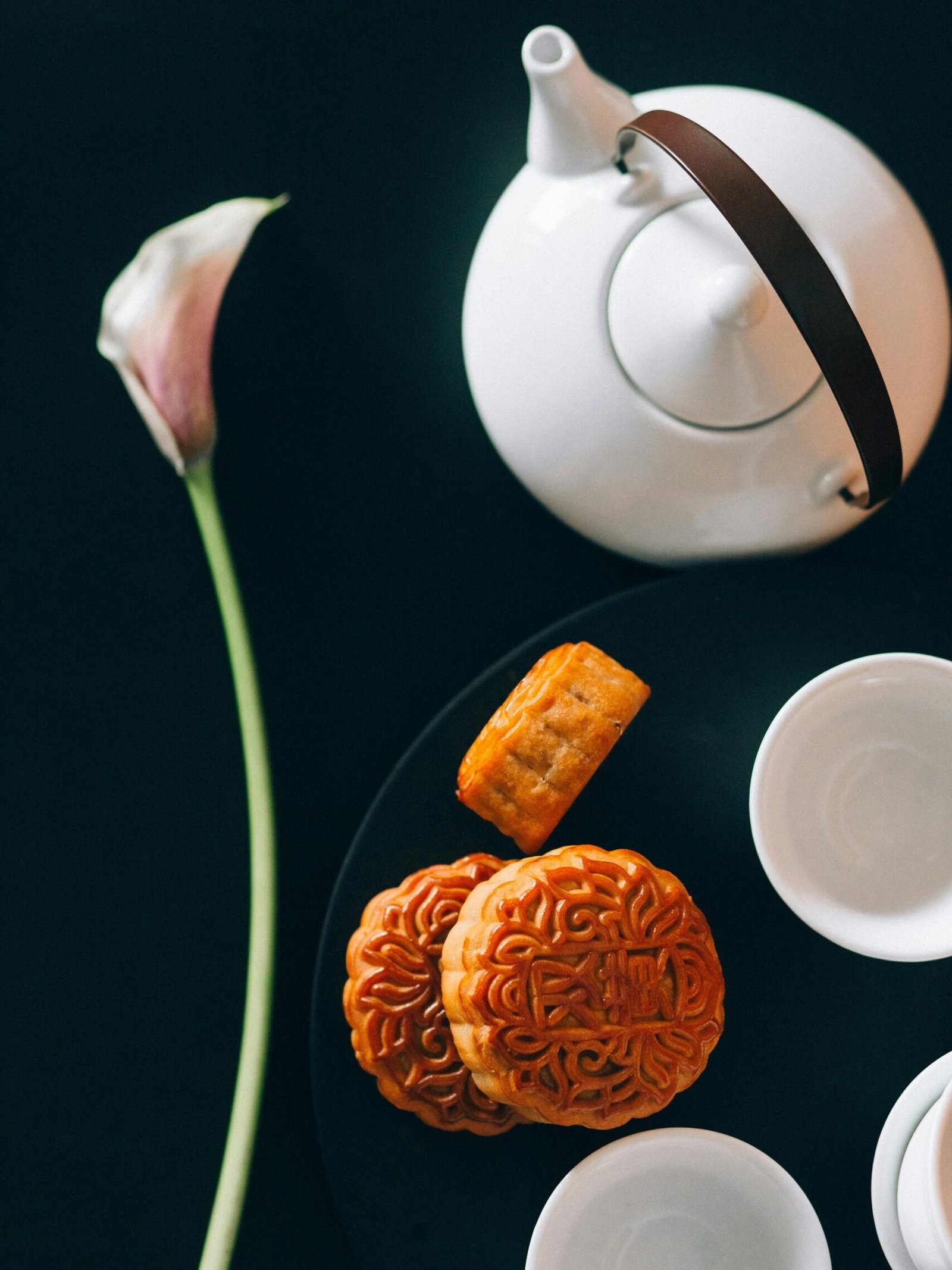
This pairing creates a harmonious balance that makes every bite more enjoyable for both beginners and seasoned food lovers who want to explore what foods go well with oolong beyond milk or curry options.
Oolong with Mooncakes
Oolong tea stands as a popular pairing for mooncakes during the Mid-Autumn Festival in China. The custom brings together oolong’s mild astringency with the dense sweetness found in mooncake fillings.
Lighter oolongs, like those high in floral and fruity notes, enhance lotus seed or fruit-filled pastries. Roasted varieties taste excellent next to nut, red bean, or salted egg yolk versions.
Oolong’s ability to be brewed multiple times complements long celebrations. It matches the slow enjoyment of each bite.
Many Chinese households embrace this sensory tradition year after year. Oolong highlights subtle flavors within traditional mooncake recipes often overlooked when paired with coffee or black and green teas.
Its complex flavor profile cuts richness, helping your palate stay refreshed as you sample different types of cakes.
What Breakfast and Brunch Foods Go with Oolong?
Breakfast and brunch foods shine when paired with oolong tea. This pairing adds a subtle layer of complexity to every bite.
Oolong with Eggs Benedict
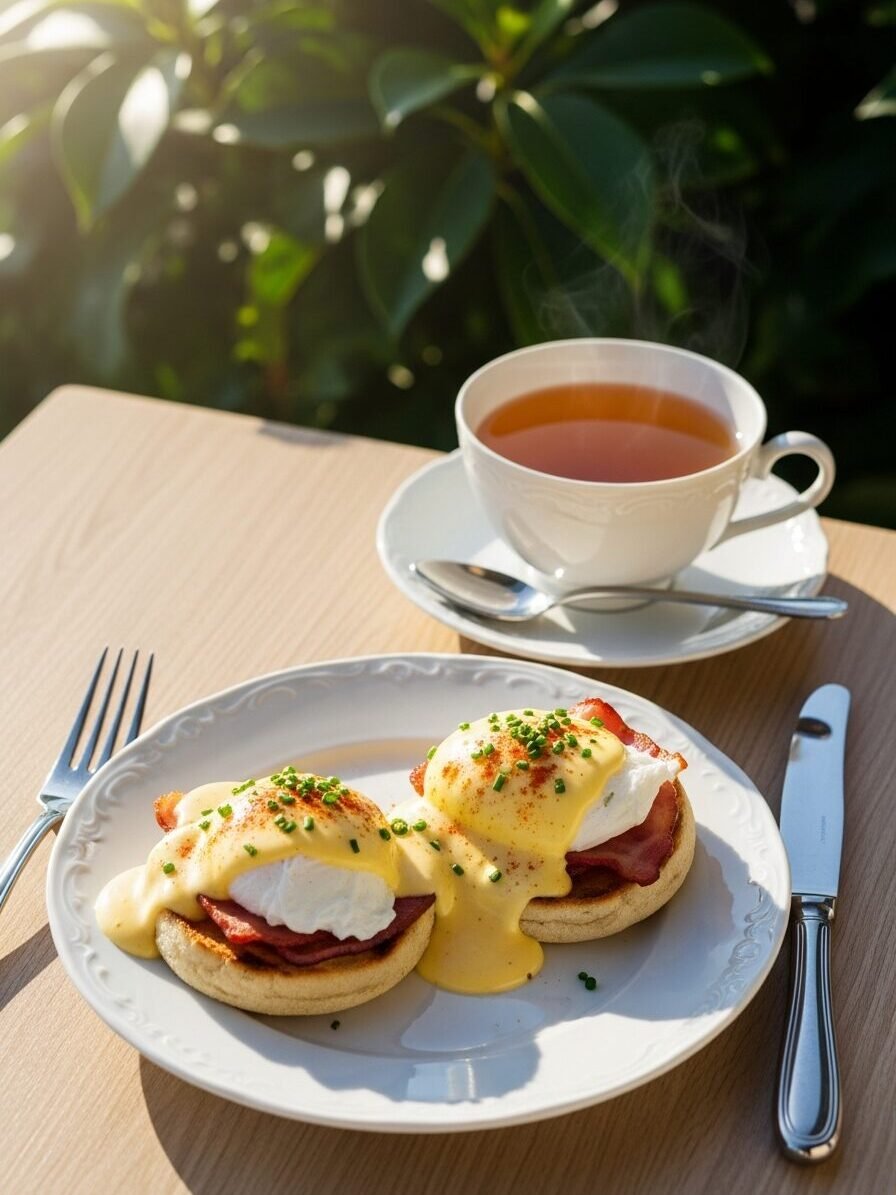
Medium oolong tea matches the richness of Eggs Benedict, especially with its balanced roasted or nutty notes. A popular choice like Dong Ding provides just enough body to partner with creamy hollandaise and soft poached eggs.
The complex flavors in oolong cut through the buttery sauce and toasted English muffin. This makes every bite feel lighter on your palate.
Oolong’s gentle astringency refreshes you between mouthfuls so that each taste remains distinct. Sipping hot oolong brings out subtle herbal hints from both the tea and dish.
Adding citrus or mint garnishes on top of Eggs Benedict can tie into fruity or floral notes in your cup of tea. This creates a satisfying brunch pairing experience for those who enjoy thoughtful flavor combinations.
Oolong with Croissants
Lightly oxidized oolongs, especially those with a creamy or floral profile, match beautifully with croissants. Alishan oolong stands out for this pairing because of its gentle sweetness and subtle creaminess.
The buttery flavor in croissants works well with the tea’s delicate aroma and understated notes. Sipping light oolong helps highlight both plain and filled pastries like chocolate, almond, or fruit croissants.
Serving oolong slightly cooled enhances the experience. It draws out more pastry flavors without overpowering them.
This combination fits perfectly at breakfast or during afternoon tea sessions. Oolong’s balanced character lets you enjoy the flaky texture of fresh-baked croissants while appreciating every nuance in your cup.
Oolong with Fruit Tarts
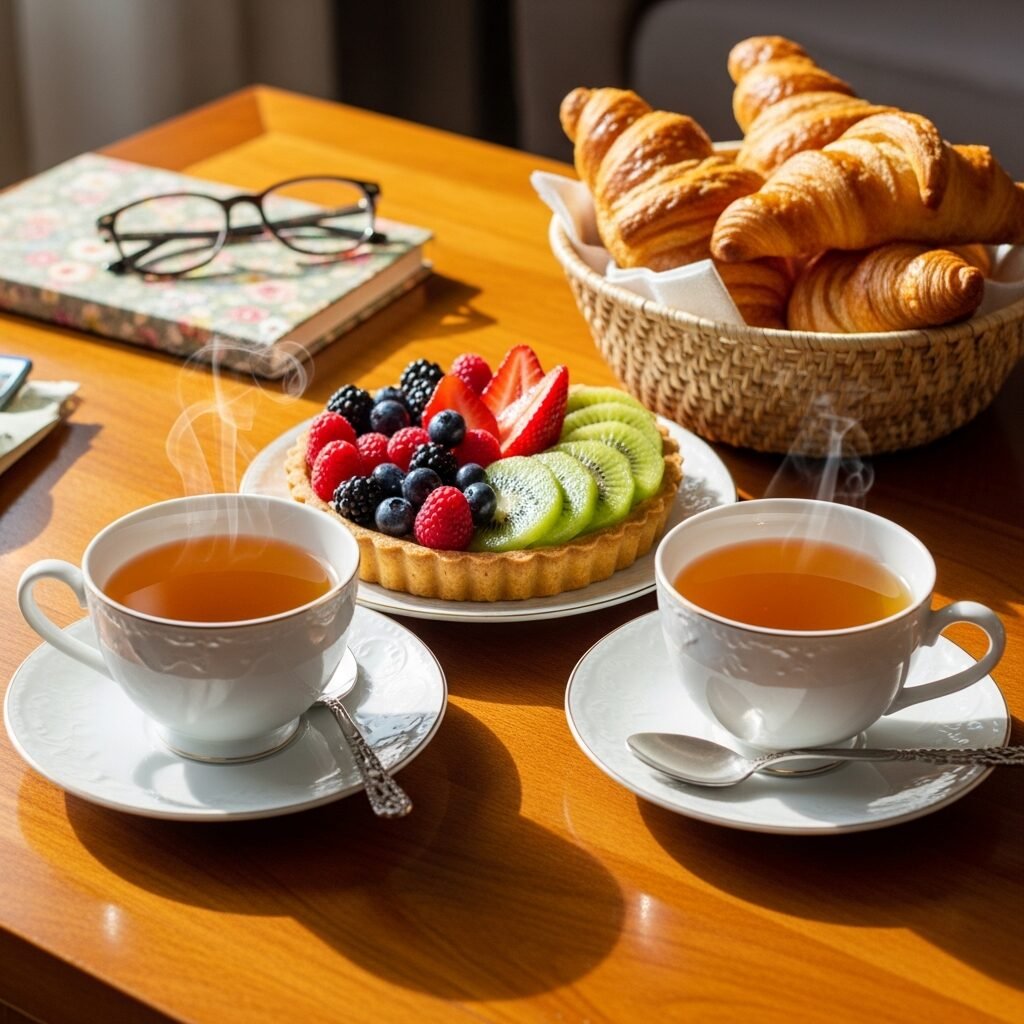
Light oolongs with floral or fruity notes make a great pairing for fruit tarts. Pear Mountain Oolong, also called Lishan, stands out with its honey and blossom flavors.
The tea’s gentle acidity matches the creamy fillings. It highlights both the tartness and sweetness of fresh berries or kiwi on top.
This match works well for brunch tables or dessert courses. Many patisseries choose this combination because it allows both the delicate pastry crust and the bright, juicy fruit to shine beside the smooth tea profile.
Serving light oolong iced adds a refreshing twist to this classic duo. A cup of lightly oxidized oolong brings balance without overpowering your palate, letting every element stand out in harmony.
How to Pair Oolong with Dinner Dishes
Pairing oolong with dinner dishes highlights its complex flavors alongside a wide range of savory foods. You can explore different cuisines and let your taste buds guide the experience for each meal.
Oolong with Roasted Poultry
Dark oolong teas such as Da Hong Pao pair well with roasted poultry like duck, chicken, and even turkey. The tea’s smoky and mineral-rich flavors echo the crispy skin and juicy meat.
These toasty notes align closely with rosemary, thyme, or other herbs often found in roasted bird recipes. Chefs value this pairing during colder seasons since a hot cup of oolong enhances both flavor and warmth at dinner tables.
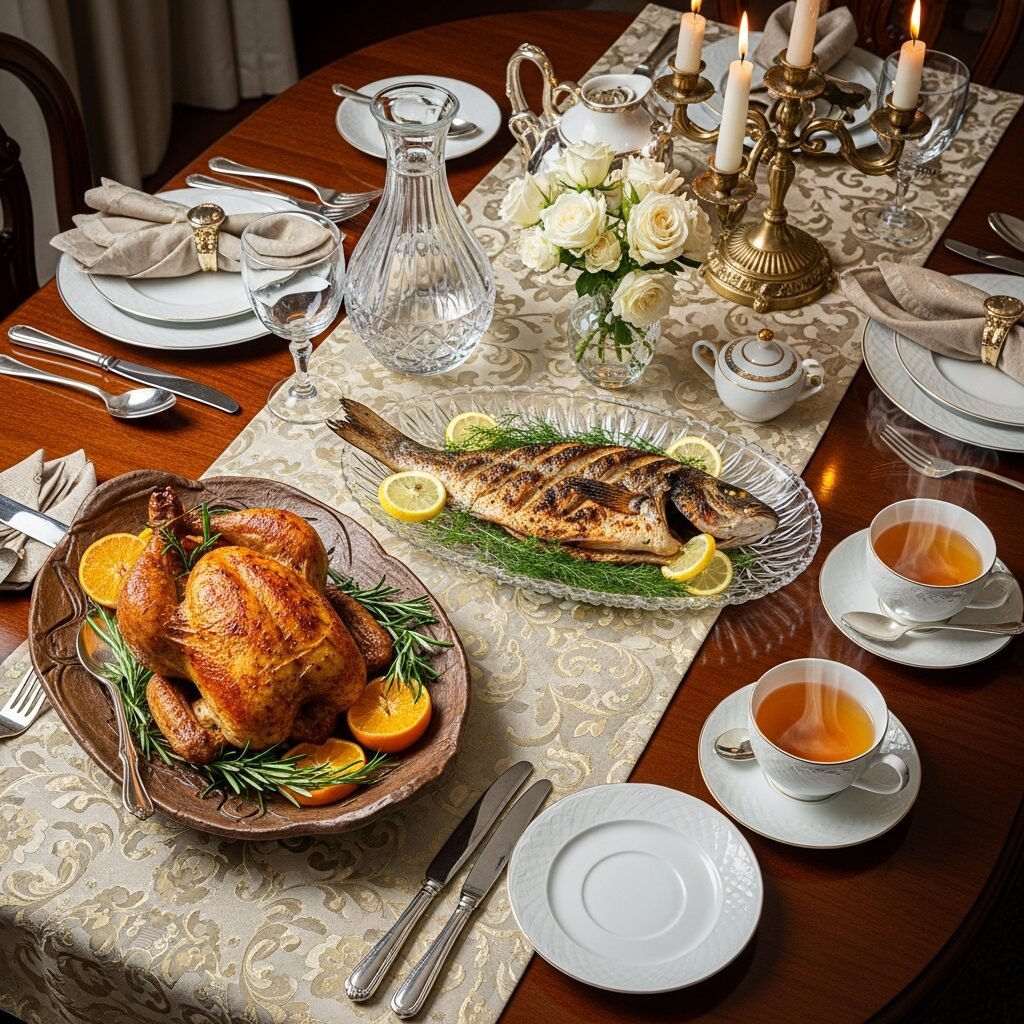
The ability of dark oolong to cut through fat adds balance. It works especially well when served alongside richer poultry dishes or game birds.
Taiwanese and Chinese culinary traditions use this match for fall or winter feasts because it brings depth without overpowering the meal. Your guests will enjoy how the strong tea accentuates savory seasonings yet refreshes the palate after each bite.
Oolong with Grilled Fish
High Mountain Oolong makes an excellent choice for pairing with grilled fish. The tea’s floral and crisp notes lift the flavors of simply seasoned, flaky white fish such as cod or tilapia.
Its gentle astringency helps cleanse your palate after each bite. Every forkful tastes fresh.
Tea experts recommend serving oolong slightly cooled or over ice during summer meals to keep things light and refreshing. Lightly roasted oolongs match well with herb-marinated grilled fish since subtle teas mirror the soft flavors in the dish.
Lemon zest or citrus garnish in the meal highlights natural fruit undertones in the tea. This brings both elements together beautifully.
You can choose this pairing if you want a healthy dinner that feels elegant yet easy to prepare at home.
Oolong with Creamy Pasta

After savoring grilled fish with oolong, creamy pasta eagerly awaits its perfect tea companion. Medium oolongs like Dong Ding balance the rich flavors of cream-based sauces using their complex, roasted aromas.
Oolong’s light astringency refreshes the palate between each bite of luscious sauce and tender noodles. Both vegetarian and meat-based creamy pastas shine alongside this pairing.
Nutty undertones in oolong enhance dishes with mushrooms or earthy truffles. This makes each spoonful more satisfying.
Serving hot tea helps cut through pasta’s heaviness. It creates a comforting experience that feels indulgent but never overwhelming.
What Desserts Complement Oolong Tea?
Oolong tea enhances sweet treats with its floral and toasty notes. You can enjoy the complex fragrance of oolong as it highlights new dessert experiences.
Oolong with Caramel Desserts
Dark roasted oolongs like Da Hong Pao stand out with their caramel and toasted notes. This makes them a natural fit for pairing with caramel desserts.
The tea’s lingering butter flavors highlight the rich taste of caramel sauces or creamy fillings. You’ll find this in treats such as flan, salted caramel cakes, or classic caramel custards.
Its dense mineral profile balances the sweetness in these desserts. Each bite feels less sugary and more complex.

Served hot alongside sticky toffee puddings or dense caramel bars, this type of oolong enhances both dessert texture and taste. It cuts through heaviness while amplifying aroma.
This combination delivers an experience well suited for chilly months when people crave warmth and bold flavor contrasts from their food and drink choices.
Oolong with Nut-Based Sweets
Oolong tea brings out the best in nut-based sweets due to its rich and complex profile. Almond cookies and walnut tarts make excellent companions for both light and roasted oolongs.
The gentle sweetness of these desserts pairs with oolong’s aromatic notes. This creates a layered experience for your taste buds.
The texture of nuts, whether crunchy or creamy, emphasizes the body of the tea. Honey or chocolate add depth to each pairing.
This match honors tradition while elevating both elements on your table. Serving oolong tea alongside nutty pastries showcases flavor harmony in a meaningful way.
Oolong with Stone Fruit Desserts
Following oolong’s pairing success with nut-based sweets, stone fruit desserts offer even more opportunities for tea and dessert harmony. Peach cobbler and plum tart highlight the fruity notes in many oolong teas.
Floral undertones elevate the juiciness of peaches, plums, and cherries found in baked goods or fresh slices. A lightly sweetened cup matches perfectly with stone fruit sorbet, bringing a refreshing contrast on warmer days.

Toasty flavors from certain oolongs add depth to pastries like cherry galettes or apricot cakes. The tea’s complex profile balances both rich desserts and lighter options such as nectarine yogurt parfaits.
You can serve these combinations together at gatherings. Your guests will notice how each bite brings out new dimensions in both the tea and dessert experience.
Conclusion: Exploring Oolong’s Pairing Possibilities
Pairing oolong tea with food opens new possibilities for your table. Each variety, from floral to roasted, finds a perfect match among cheeses, meats, pastries, and fruits.
You can experiment with both traditional Chinese dishes and Western favorites like eggs Benedict or chocolate desserts.
Try different combinations to discover how oolong’s complex flavor enhances each bite. With the global oolong tea market projected to grow steadily through 2033, more tea enthusiasts are discovering these delightful pairings every day.
Taste the difference as you explore what pairs well with oolong tea in every meal.
FAQs
1. How does the oxidation level of Oolong tea determine what food I should serve with it?
The oxidation level is the primary guide for pairing because it dictates the flavor intensity. Lightly oxidized oolongs (under 50%) are floral and bright, similar to green tea, making them perfect for delicate foods like seafood and fruit. Heavily oxidized oolongs (over 50%) are dark, roasted, and woody, resembling black tea; these are strong enough to pair with rich meats, spicy dishes, and aged cheeses.
2. I am serving a heavy, savory meal like BBQ or smoked meat. Which Oolong is the best fit?
You should choose a dark roasted Oolong, such as Wuyi Rock Tea (Da Hong Pao). These teas have a mineral-rich, smoky profile with hints of caramel and toast that can stand up to bold flavors. They are specifically recommended for cutting through the richness of fatty dishes like pork belly, roast duck, or ribs, and they enhance the umami found in grilled preparations.
3. What are the best options for pairing Oolong with lighter fare like seafood or salads?
Opt for High Mountain Oolong or Alishan Oolong. These light varieties possess crisp, grassy, and floral notes that complement rather than overpower delicate textures. They pair exceptionally well with poached fish, scallops, shrimp, and sushi. The tea’s natural sweetness and slight astringency also work to balance briny flavors like oysters.
4. Does drinking Oolong tea actually help with the sensation of eating greasy foods?
Yes. According to a study by the Suntory Global Innovation Center, Oolong tea has the ability to emulsify fats. This helps remove oils from the mouth and reduces the sensation of greasiness, effectively cleansing the palate. This makes it an ideal companion for heavy foods like fried dim sum, creamy pasta, or salami, as it refreshes the taste buds between bites.
5. How do I pair Oolong with dessert without clashing flavors?
Match the tea’s roast level to the dessert’s richness. For light, fruit-based desserts (like berry tarts, pavlova, or stone fruits), use a floral light Oolong to amplify the sweetness. For rich, heavy desserts like dark chocolate (70%+ cocoa), caramel, or toffee, use a dark roasted Oolong. The roasted tea’s woody, buttery notes mirror the profile of coffee or nuts, making it a perfect match for decadent sweets.
6. What makes Medium Oolong a good choice for brunch dishes like Eggs Benedict?
Medium Oolong, such as Dong Ding, offers a balance between floral and roasted notes that is versatile enough for complex brunch plates. Its roasted aroma complements nutty or toasted flavors (like English muffins), while its astringency cuts through rich, buttery sauces like hollandaise. It also pairs well with quiches and croissants by highlighting the pastry texture without masking mild ingredients.
7. If I am eating traditional Chinese cuisine, which specific pairings are recommended?
For Dim Sum (dumplings, bao, spring rolls), choose a lightly oxidized tea like Tie Guan Yin to cut through fried textures and complement shrimp fillings. For heavier banquet dishes like Peking Duck, choose a dark Wuyi Oolong to handle the crispy skin and hoisin sauce. For Mooncakes, match the filling: floral teas for lotus seed/fruit, and roasted teas for nut or red bean fillings.
8. Can I pair Oolong tea with cheese, and if so, what kind?
Yes, Oolong pairs surprisingly well with cheese. Light Oolongs provide a smooth mouthfeel that balances soft cheeses and creamy textures. Conversely, dark roasted Oolongs are excellent with aged, pungent cheeses like Gouda, Cantal, or sharp Cheddar, as the tea’s mineral and smoky notes amplify the cheese’s savory, nutty qualities.



